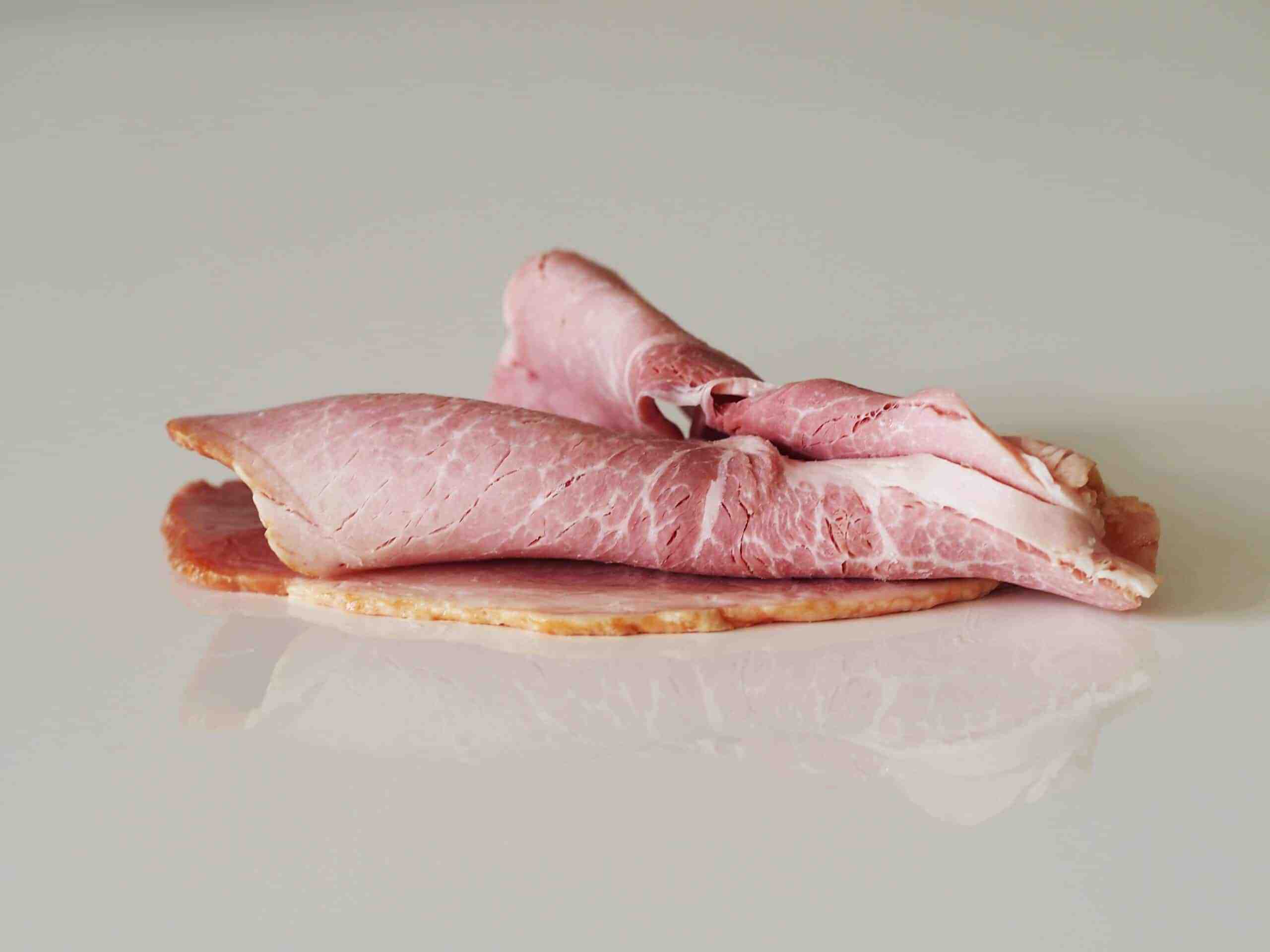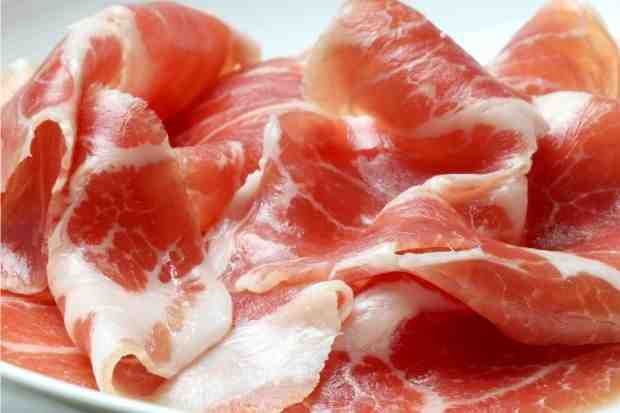What is a Uncooked ham?

Raw ham refers to salt and air cured pork, also known as dry curing. On the same subject : Is raw hamburger safe to eat?. Dry curing is time consuming, but it adds a rich flavor that is appreciated by cultures around the world.
Quel morceau pour la bresaola? La bresaola is a special Italian producer of cold cuts in Lombardy, près de la Suisse. Elle est réalisée à partir de viande de bä’uf aromatisée, salée et séchée. Les morceaux utilisés sont la noix ou le gîte. C’est une viande maigre qui présente une bonne qualité Nutritionnelle.
Comment conserver la bresaola ?
La bresaola se conserve au réfrigérateur. Le temps de protection dépend du type de bresaola achetée. On the same subject : What happens if you eat raw hamburger?. The meats are déjà découpée in tranches, they are at worst. 2 à 3 jours après ouverture semble le délai optimum pour conserver la fraîcheur et la saveur de la bresaola.
Comment est faite la bresaola ?
La Bresaola est obtenue après séchage de viande de bâ “uf dégraissée, épicée, poivrée et salée. C’est une charcuterie italienne très réputée. This may interest you : Is Salami a raw meat?. Également appelée Bresaola della Valtellina, cette spécialité est dotée d’une Indication Géographique Protégée.
Comment est fait la viande de grison ?
Amis du web, sachez que la viande des grisons est fabrique à base de viande de bäuf, et plus particulièrement d’un morceau tendre de la cuisse de bäuf (le tende de tranche). Cette charcuterie tire donc tout simplement syn nom de la région du Canton de Grisons en Suisse.
Comment est fait la viande séchée ?
The cell consists of simplement à saler la viande puis à la déshydrater. Cette méthode était déjà utilisée par nos ancêtres pour conserver la viande plusieurs mois durant avant l’invention de la chaîne du froid et du refrigérateur.
Comment est fait le Grison ?
Elle est faite à partir d’une cuisse de bovin de prvenance non définie et de sels (sels de sodium et nitrité), herbes des Alpes suisses et épices (poivre, ail, laurier, genièvre, clou de girofle). Une fois salée à cÅ “ur, la pièce de viande est séchée.
How do I know if my ham is raw or cooked?

How to check if a ham is fully cooked. You will be able to identify the fully cooked ham by reading the label. In fact, the packaging – and not the appearance of the meat – is the only way to know if the ham is fully cooked, says Matijevich. A fully cooked ham will not have “thoroughly cooked” on its packaging.
What is the difference between cooked and uncooked ham? A ham is a piece of pork that comes from a pig’s hind leg. A fresh ham is one that has not been cured or smoked. This means that it is raw pork that needs to be cooked completely, which, depending on the size of the ham, can take around 5 hours.
Are all hams pre cooked?
Most hams sold in the US are cured and fully cooked, but even then it can take several hours to preheat in the oven. At 325 degrees F, a 6-pound cooked bone-in smoked ham would take nearly 2.5 hours to heat up to an internal temperature of 140 degrees.
Does all ham come precooked?
In short, if the ham is cured, smoked or baked, the ham is considered “precooked” and technically does not need to be cooked. This includes the ham purchased at the deli. In fact, most hams sold to consumers are already cured, smoked or baked.
How do you tell if a ham is precooked?
A fully cooked ham will not have “thoroughly cooked” on its packaging. Instead, it may say “precooked”. If not, the label on the ham should include reheating (no boiling) instructions, which would indicate that the meat is pre-cooked.
How do you tell if ham is precooked or not?
A fully cooked ham will not have “thoroughly cooked” on its packaging. Instead, it may say “precooked”. If not, the label on the ham should include reheating (no boiling) instructions, which would indicate that the meat is pre-cooked.
How can you tell if a ham is done without a thermometer?
Step at an angle in the center of the cut, wait a second, then hold the tester against your wrist. If it’s cold, the meat is raw. If it is warm – close to body temperature – the meat is rarely done. If it’s hot it’s well done.
What does raw ham look like?
Usually the color of cured ham is dark pink or pink. Fresh ham (the one that has not been cured) will have a light pink or beige color, similar to the color of a fresh roast pork. The farm ham and prosciutto (both dry-dried) range in color from pink to mahogany. The hams may or may not be ready.
What is raw ham?
Rate and review. A ham that is first treated with a mixture of salt and then subjected to a natural process of curing in the air, which dries and flavor the meat.
Is there such a thing as raw ham?
Classic antipasto platter with raw ham. Raw ham refers to salt and air cured pork, also known as dry curing. Dry curing is time consuming, but it adds a rich flavor that is appreciated by cultures around the world.
How do you treat trichinosis?

Depending on the symptoms and the severity of the infection, your doctor may prescribe: Antiparasitic drugs. This is the first line of treatment for trichinosis infection. If an infection is detected early, taking albendazole or mebendazole can eliminate the worms and larvae in the intestine.
What Kills Trichinella? Thorough cooking of meat can kill Trichinella larvae, and freezing pork (but not wild animal meat) usually kills the larvae. Antiparasitic drugs such as albendazole can eliminate worms from the gut but not the larvae in the muscles, and painkillers are needed to relieve muscle pain.
How long does trichinosis last?
These symptoms can last anywhere from 5 to 45 days, but usually begin to appear 10 to 14 days after eating contaminated meat. Milder cases of trichinosis are often confused with the flu or other common illnesses. In extreme cases, trichinosis can be fatal.
What are the stages of trichinosis?
Trichinellosis usually progresses through 3 phases and important clinical features of acute disease, if they develop, include an intestinal (enteric) phase with diarrhea for 1-2 weeks, followed by a parenteral (invasive) phase consisting of malaise, fever, progressive (often marked) eosinophilia and widespread …
What can happen if you don’t get treated for trichinosis?
Complications with trichinosis are rare except in severe cases. When heavily infested, the larvae can migrate to vital organs, causing potentially dangerous and even fatal complications, including: Myocarditis – inflammation of the heart muscle, the thick layer of muscle in the heart wall.
Can trichinosis be treated with antibiotics?
Trichomoniasis is usually treated quickly and easily with antibiotics. Most people are prescribed an antibiotic called metronidazole, which is very effective if taken correctly. Usually you will need to take metronidazole twice a day for 5 to 7 days. Sometimes this antibiotic can be prescribed in a single larger dose.
What’s the best treatment for trichinosis?
Antiparasitic drugs are the first line of treatment for trichinosis. If the trichinella parasite is detected early, albendazole (Albenza) or mebendazole (Emverm) may be effective in eliminating worms and larvae in the intestine.
How long does it take for trichinosis to go away?
The following classic symptoms of trichinosis often develop within 2 weeks of eating contaminated meat and can last up to 8 weeks: Muscle pain. Fever. Swelling of the face, especially the eyes.
How do you know if you have trichinosis?
These symptoms usually include diarrhea (loose stools / stools), nausea (feeling sick in your stomach), tiredness and abdominal pain. Other symptoms may appear 2-8 weeks after infection and may include fever, headache, chills, muscle soreness, pain and swelling around the eyes.
How do you test for trichinosis?
Your doctor may use the following tests to confirm the diagnosis: Blood tests. Your doctor may take a blood sample and test it for symptoms that suggest trichinosis – an increase in a certain type of white blood cell (eosinophil) or the formation of antibodies against the parasite after a few weeks.
What is the incubation period for trichinosis?
The usual incubation period for trichinosis is 8-15 days. After incubation in the intestine, the initial symptoms most often affect the gastrointestinal tract due to invasion of the intestinal wall by juvenile larvae.
Can ham be pink in the middle?
When cooking pork chops or pork tenderloin, they should brown before they can be eaten safely. However, the ham is usually pink when ready.
Why is my ham pink? Hams which use nitrates and / or nitrites as curing agents undergo pigment changes under the influence of light and air as a result of a chemical reaction. The same nitrates keep the meat pinkish red, even when fully cooked.
How can you tell if ham is undercooked?
USDA recommendation says, “Set the oven temperature to 325 ° F. Before removing the meat from the heat source, cook all raw fresh ham and ready-to-eat ham to a minimum internal temperature of 145 ° F, measured with a food thermometer.
What happens if I eat undercooked ham?
Human infections can occur worldwide, but are most common in areas where raw or undercooked pork is eaten, such as ham or sausage. What are the symptoms of trichinosis? Nausea, diarrhea, vomiting, fatigue, fever and abdominal discomfort are the first symptoms of trichinosis.
Can ham be pink in the middle?
The typical color of cured ham is dark pink or pink; fresh ham (uncured) has a light pink or beige color of fresh roast pork; The farmhouse ham and prosciutto (dry-cured) range in color from pink to mahogany. The hams are either ready to eat or not.
Can you eat ham pink?
In short, yes! We used to fear pink pork because of a parasite known as trichinosis, but today the risk of contracting it is virtually non-existent. Like beef, pork temperatures are designed to cook meat long enough to nix E.
What color is ham when it’s cooked?
Fresh hams are pieces from the hind leg that are not cured or smoked. When raw they are grayish-pink, and when cooked, they are greyish-white. Fresh hams are cooked using the same methods as other fresh pork cuts and have a similar flavor to roast pork.
Can ham be pink in the middle?
The typical color of cured ham is dark pink or pink; fresh ham (uncured) has a light pink or beige color of fresh roast pork; The farmhouse ham and prosciutto (dry-cured) range in color from pink to mahogany. The hams are either ready to eat or not.
What happens if you eat pink pork?
What happens if I eat undercooked pork? Eating undercooked pork can cause diseases such as food poisoning or trichinosis. Pork products that contain both meat and fatty by-products (bacon, shoulder roast) are most likely to be infected with trichinella. Eating undercooked pork can cause food poisoning.
Can you eat medium rare pork? Pork is now safe to eat when served medium rare or “pink”. This is achieved when the internal cooking thermometer reaches 145 ° F at its thickest part, then the meat is allowed to stand for 3 minutes after cooking.
What Colour should pork be when cooked?
| The quality of the pork | End-point temperature and time at this temperature | |
|---|---|---|
| 145 ° F (63 ° C), 3 min | 170 ° F (77 ° C), 1s | |
| Normal | Pink | Light brown / white |
| Normally injected | Pink | Light brown / white |
| PSE | Light pink | Light brown / white |
Is it OK to eat pink pork?
A little pink is okay: USDA changes pork cooking temperature: The bidirectional US Department of Agriculture has lowered the recommended pork cooking temperature to 145 degrees Fahrenheit. This, he says, may make some pork look pink, but the meat is still safe to eat.
Can pork be pink when fully cooked?
At 145 ° C, some pork in larger pieces may still be pink and the juices may have a pink tinge, but the meat is fully cooked and safe to eat. Larger pork chops can have a pink tinge even when fully cooked.
Can you eat pork if it’s pink in the middle?
A little pink is okay: USDA changes pork cooking temperature: The bidirectional US Department of Agriculture has lowered the recommended pork cooking temperature to 145 degrees Fahrenheit. This, he says, may make some pork look pink, but the meat is still safe to eat.
Can pork have a little pink in the middle?
In short, yes! We used to fear pink pork because of a parasite known as trichinosis, but today the risk of contracting it is virtually non-existent. Like beef, pork temperatures are designed to cook meat long enough to eliminate E. coli, meaning it may have some color inside.
How do you know if pork is undercooked?
Pork safe internal cooking temperature for fresh cuts is 145 ° F. Use a digital cooking thermometer to check the dough properly. Freshly sliced muscle meats such as pork chops, roast pork, pork tenderloin, and tenderloin should be at 145 ° F for maximum flavor.
Is it OK to eat pork that’s slightly pink?
This color does not indicate anything nefarious – at 145 ° C your pork is “medium rare” temperature. You’d expect to see some pink in a medium rare steak, so don’t be surprised to find it in your pork chops! If the pink color scares you, you can continue cooking until it reaches 155 ° F.
How can you tell if pork is underdone?
While thermometers are the best way to tell if pork is ready, you can judge whether it is done by the color of the juices it comes out of when you pierce it with a knife or fork. If the pork juices are clear or very slightly pink, the pork is ready.
Sources :
